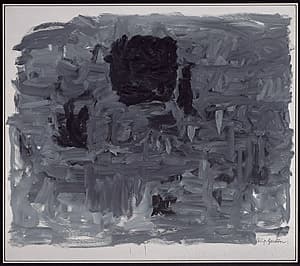

Philip Guston
Learn moreProspects 1964
Gift of American Friends of the National Gallery of Australia, Inc., New York, NY, USA, made possible with the generous support of Musa Guston 1992
More detail | PermalinkIn 1950, following his return to New York from a year travelling in Italy, Philip Guston became immersed in the fervour of the art scene and was an active member of the ‘Eighth Street Club’, which included artists such as Robert Motherwell and Mark Rothko. He had a mid-career retrospective at the Solomon R Guggenheim Museum, New York, in 1962 and four years later a second major survey was held at the Jewish Museum, New York, at which Prospects 1964 was shown. The exhibition brought together almost 40 paintings completed between 1960 and 1965, and was conspicuous in its austerity. During the 1960s the artist gradually expunged colour from his palette, and for Prospects he limited his palette to black and shades of grey only. Guston explained his approach:
I use white and black pigment; white pigment is used to erase the black I don’t want and becomes grey. Working with these restricted means as I do now, other things open up which are unpredictable, such as atmosphere, light, illusion—elements which do seem relevant to the image but have nothing to do with color.[1]
Robert Storr observed that by 1962 the struggle between figure and ground in Guston’s work had been resolved in the separation of the two.[2] In his paintings of the mid 1960s, forms stand out against the background and usually occupy the centre of the canvas, as is the case with the principal squarish form and subsidiary fragments ‘grouped’ in Prospects.[3] While the black elements are pronounced, the intertwining of Guston’s brushstrokes means that these features never fully disengage from the grey; they are distinguishable yet still grounded in the weave of the brushstrokes. The title suggests that at this time the artist was contemplating the direction his work would take in the future. While there may appear to be a uniformity to his output, particularly in 1964 and 1965, his titles, which use words such as ‘portrait’ or ‘head’, hint at a personification of the forms. Although not yet necessarily recognisable as ‘images’, the titles allude to Guston’s thoughts.
Reviews of Guston’s 1966 exhibition were mixed, not surprising given the shifting artistic climate in New York.[4] When Prospects was first shown at the National Gallery of Australia in 1994, Michael Desmond observed that the painting marked ‘a crisis point in Guston’s career’:
This is part of the evolutionary moment between 1962 and 1968 in which he questioned the meaning and content of his work. The dark forms on grey background in this painting are coalescing into images, almost in spite of the artist … ‘doubt has form’.[5]
Between the end of 1965 and late 1967, Guston stopped painting, concentrating instead on drawing as a means of solving the problems he faced as an artist. When he returned to painting, he entered a new phase in his work.
Steven Tonkin
[1] William Berkson, ‘Dialogue with Philip Guston, November 1, 1964’, Art and literature: An international review 7, Winter 1965, p 56.
[2] Robert Storr, Philip Guston, Abbeville Press, New York, 1986, pp 42–3.
[3] These identifiable features are reduced even further to a single black form characterised by short brushstrokes in Air II 1965, Yale University Art Gallery, New Haven.
[4] Only two months after his exhibition at the Jewish Museum, Primary structures opened at the same venue, and later that year the seminal exhibition Systemic painting was held at the Solomon R Guggenheim Museum, both heralding the concerns of a new generation of artists; see discussions in Dore Ashton, Yes, but … a critical study of Philip Guston, The Viking Press, New York, 1976, pp 133–5; Storr, p 43.
[5] Michael Desmond, ‘Rehanging the galleries: The return of modern art’, National Gallery News, March–April 1994, p 7.

